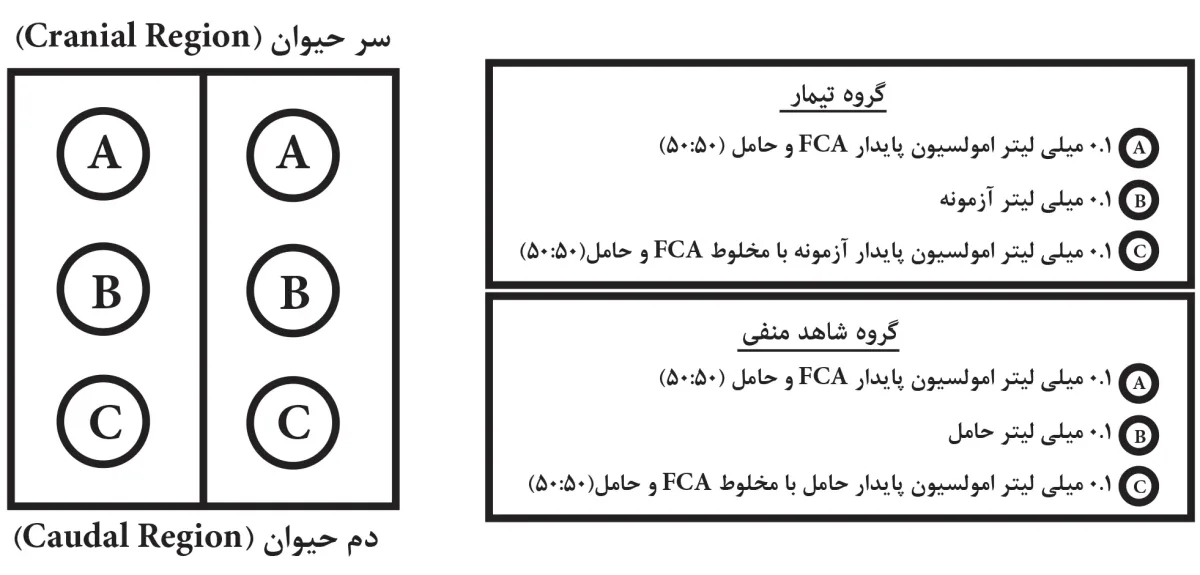
تست حساسیت زایی پوستی در خوکچه هندی | Closed-Patch / Buehler Test
تست حساسیت زایی پوستی پچ بسته خوکچه هندی |Closed-Patch / Buehler Test
تست حساسیت زایی پوستی با استفاده از يك مدل حیوانی مناسب جهت برآوردن الزامات زیست سازگاری و ارزیابی خطرات سمیت (toxicological risk assessment) تجهیزات پزشکی (medical devices)، داروها (pharmaceuticals)، سم و آفت کش (pesticides)، محصولات آرایشی و بهداشتی (cosmetics)، مواد شیمیایی صنعتی (chemicals) و محصولات مصرفی (consumer products) بکار می رود. تست حساسیت زایی پوستی Buehler، در صنایع سم و آفت کش و شوینده بسیار رایج است و طول تست حدود 30 تا 35 روز می باشد.
در مجموعه آزمایشگاه های سنجش و پایش کیاژن فارما، تست حساسیت زایی پوستی پچ بسته خوکچه هندی (Buehler test) بر اساس استاندارد ISO 10993-10 انجام می شود و هدف از آزمون، ارزیابی پتانسیل حساسیت زایی موادی است که امکان انجام تست GPMT وجود ندارد یعنی در مواردیکه امکان تزریق نمونه یا عصاره استخراج شده از آن به بدن حیوانات آزمون وجود ندارد مانند انواع شوینده، ضدعفونی کننده، آفت کش و مواد شیمیایی و صنعتی و همچنین موادیکه در کاربری بالینی به صورت موضعی (topically) استفاده می شوند مانند الکترود کاردیوگرام.
توضیحات محصول
#آزمون Buehler#آزمون closed patch#آزمون closed-patch#آزمون حساسیت پوستی پچ بسته در خوکچه هندی#آزمون حساسیت پوستی پچ بسته خوکچه هندی#آزمون حساسیت زایی پوستی بوهلر#آزمون حساسیت زایی بوهلر#آزمون حساسیتزایی پوستی بوهلر#آزمون حساسیتزایی پوستی در خوکچه هندی#آزمون حساسیتزایی پوستی در خوکچه هندی#آزمون حساسیت زایی پوستی در خوکچه هندی#آزمون بوهلر#Hcl,k f,igv#Hcl,k \] fsji o,;]i iknd##تست Buehler#تست closed patch#تست closed-patch#تست حساسیت پوستی پچ بسته در خوکچه هندی#تست حساسیت پوستی پچ بسته خوکچه هندی#تست حساسیت زایی پوستی بوهلر#تست حساسیت زایی بوهلر#تست حساسیتزایی پوستی بوهلر#تست حساسیتزایی پوستی در خوکچه هندی#تست حساسیتزایی پوستی در خوکچه هندی#تست حساسیت زایی پوستی در خوکچه هندی#تست بوهلر#jsj f,igv#jsj pshdj chdd \,sjd f,igv#آزمایش Buehler#آزمایش closed patch#آزمایش closed-patch#آزمایش حساسیت پوستی پچ بسته در خوکچه هندی#آزمایش حساسیت پوستی پچ بسته خوکچه هندی#آزمایش حساسیت زایی پوستی بوهلر#آزمایش حساسیت زایی بوهلر#آزمایش حساسیتزایی پوستی بوهلر#آزمایش حساسیتزایی پوستی در خوکچه هندی#آزمایش حساسیتزایی پوستی در خوکچه هندی#آزمایش حساسیت زایی پوستی در خوکچه هندی#آزمایش بوهلر#jsj f,igv#jsj pshdj chdd \,sjd f,igv
تست حساسیت زایی پوستی پچ بسته در خوکچه هندی | Closed-Patch / Buehler Test
هدف از تست حساسیت زایی پوستی پچ بسته خوکچه هندی (Buehler test)، ارزیابی پاسخ شدید سلولی سیستم ایمنی (cellular hypersensitivity) ناشی از تماس مواد با بدن خوکچه هندی می باشد. حساسیت زایی بعد از یک یا چند بار تماس ماده آزمایشی با بدن و معمولا در اثر تحریک سیستم ایمنی بواسطه نفوذ مواد آزاد شده (leachable materials) از نمونه در بدن و چسبیدن آن به پروتئین های پلاسما و پاسخ سلول های T رخ می دهد.
در مجموعه آزمایشگاه های سنجش و پایش کیاژن فارما، تست حساسیت زایی Buehler جهت ارزیابی حساسیت زایی پوستی موادیکه امکان تزریق آن ها به صورت درون جلدی (intracutaneously / intradermally) وجود ندارد (مانند انواع شوینده، ضدعفونی کننده، آفت کش و مواد شیمیایی و صنعتی) و یا موادیکه به صورت موضعی (topically) استفاده می شوند (مانند الکترود کاردیوگرام) انجام می شود.
#آزمون Buehler#آزمون closed patch#آزمون closed-patch#آزمون حساسیت پوستی پچ بسته در خوکچه هندی#آزمون حساسیت پوستی پچ بسته خوکچه هندی#آزمون حساسیت زایی پوستی بوهلر#آزمون حساسیت زایی بوهلر#آزمون حساسیتزایی پوستی بوهلر#آزمون حساسیتزایی پوستی در خوکچه هندی#آزمون حساسیتزایی پوستی در خوکچه هندی#آزمون حساسیت زایی پوستی در خوکچه هندی#آزمون بوهلر
روش کار
در مجموعه آزمایشگاه های سنجش و پایش کیاژنفارما، تست پچ بسته (Buehler test)، بر روی ۲۰ سر خوکچه هندی و در دو فاز القایی (induction phase) و چالش / تماس (trigger/exposure/challenge phase) انجام می شود که فاز القایی جهت افزایش ظرفیت حساسیت زایی (hypersensitivity) پوست و فاز چالش جهت ارزیابی ویژگی حساسیت زایی ماده آزمایشی انجام می شود.
- موادی که پتانسیل حساسیت زایی آن ها ثابت شده است و یا pH آن ها بالای ۱۱.۵ و یا زیر ۲ است، نباید جهت آزمون های درون بدنی مورد استفاده قرار گیرند. در چنین مواردی، ماده به صورت بالقوه حساسیت زا در نظر گرفته خواهد شد.
- در بخش حیوانی کیاژن فارما، بدلیل احتمال حساسیت زا و دردناک بودن ماده آزمایشی، ابتدا یک تست مقدماتی بر روی یک حیوان انجام می شود و در صورت عدم مشکل، تست اصلی بر روی تعداد بیشتری از حیوانات (بر اساس استاندارد) انجام خواهد شد.
#تست Buehler#تست closed patch#تست closed-patch#تست حساسیت پوستی پچ بسته در خوکچه هندی#تست حساسیت پوستی پچ بسته خوکچه هندی#تست حساسیت زایی پوستی بوهلر#تست حساسیت زایی بوهلر#تست حساسیتزایی پوستی بوهلر#تست حساسیتزایی پوستی در خوکچه هندی#تست حساسیتزایی پوستی در خوکچه هندی#تست حساسیت زایی پوستی در خوکچه هندی#تست بوهلر
فاز القایی حساسیت پوستی | Induction Phase
در فاز القایی، پس از تزریق درون جلدی فروند ادجوانت کامل (Freund’s complete adjuvant)، حیوانات سه بار در هفته و به مدت سه هفته جهت افزایش ظرفیت حساسیت زایی (hypersensitivity) مطابق شکل زیر تحت تیمار با رقت های آزمایه قرار خواهند گرفت.
#آزمون Buehler#آزمون closed patch#آزمون closed-patch#آزمون حساسیت پوستی پچ بسته در خوکچه هندی#آزمون حساسیت پوستی پچ بسته خوکچه هندی#آزمون حساسیت زایی پوستی بوهلر#آزمون حساسیت زایی بوهلر#آزمون حساسیتزایی پوستی بوهلر#آزمون حساسیتزایی پوستی در خوکچه هندی#آزمون حساسیتزایی پوستی در خوکچه هندی#آزمون حساسیت زایی پوستی در خوکچه هندی#آزمون بوهلر

#تست Buehler#تست closed patch#تست closed-patch#تست حساسیت پوستی پچ بسته در خوکچه هندی#تست حساسیت پوستی پچ بسته خوکچه هندی#تست حساسیت زایی پوستی بوهلر#تست حساسیت زایی بوهلر#تست حساسیتزایی پوستی بوهلر#تست حساسیتزایی پوستی در خوکچه هندی#تست حساسیتزایی پوستی در خوکچه هندی#تست حساسیت زایی پوستی در خوکچه هندی#تست بوهلر
فاز چالش / تماس حساسیت پوستی | Trigger / Exposure / Challenge Phase
پس از یک دوره استراحت 10 تا 14 روزه از فاز القایی، فاز چالش با اعمال سطحی آزمایه در نواحی سالم بدن حیوانات انجام خواهد شد.
ناحیه تحت تیمار در 24، 48 و 72 ساعت پس از برداشتن پچ ها، از نظر علایم سرخی (erythema) و التهاب (oedema) بر اساس جدول مگنوسن و کلیگمن (Magnusson & Kligman) مورد ارزیابی دقیق قرار خواهد گرفت.
#آزمون Buehler#آزمون closed patch#آزمون closed-patch#آزمون حساسیت پوستی پچ بسته در خوکچه هندی#آزمون حساسیت پوستی پچ بسته خوکچه هندی#آزمون حساسیت زایی پوستی بوهلر#آزمون حساسیت زایی بوهلر#آزمون حساسیتزایی پوستی بوهلر#آزمون حساسیتزایی پوستی در خوکچه هندی#آزمون حساسیتزایی پوستی در خوکچه هندی#آزمون حساسیت زایی پوستی در خوکچه هندی#آزمون بوهلر
| واکنش پوستی (Patch Test Reaction) | درجه (Grading Scale) |
|---|---|
| بدون تغییر (no visible change) | ۰ |
| قرمزی واضح یا تکه ای (discrete or patchy erythema) | ۱ |
| قرمزی متوسط و پخش شونده (moderate and confluent erythema) | ۲ |
| قرمزی شدید و یا تورم (intense erythema and/or swelling) | ۳ |
#آزمون Buehler#آزمون closed patch#آزمون closed-patch#آزمون حساسیت پوستی پچ بسته در خوکچه هندی#آزمون حساسیت پوستی پچ بسته خوکچه هندی#آزمون حساسیت زایی پوستی بوهلر#آزمون حساسیت زایی بوهلر#آزمون حساسیتزایی پوستی بوهلر#آزمون حساسیتزایی پوستی در خوکچه هندی#آزمون حساسیتزایی پوستی در خوکچه هندی#آزمون حساسیت زایی پوستی در خوکچه هندی#آزمون بوهلر
درجه حساسیت زایی یک ماده تا حد زیادی به دوز القایی آن بستگی دارد، بنابراین در بخش حیوانی کیاژن فارما به ترتیب از دوز های کم تا زیاد آزمایه در آزمون استفاده خواهد شد و درصورتیکه با دوز اعمالی، آستانه تحریک ایجاد نشد، بیشترین غلظت ممکن به شرطی که سبب درد و آزردگی در حیوانات نشود یعنی دوز حد اعمال خواهد شد.
#تست Buehler#تست closed patch#تست closed-patch#تست حساسیت پوستی پچ بسته در خوکچه هندی#تست حساسیت پوستی پچ بسته خوکچه هندی#تست حساسیت زایی پوستی بوهلر#تست حساسیت زایی بوهلر#تست حساسیتزایی پوستی بوهلر#تست حساسیتزایی پوستی در خوکچه هندی#تست حساسیتزایی پوستی در خوکچه هندی#تست حساسیت زایی پوستی در خوکچه هندی#تست بوهلر
نتایج
- در صورتیکه در گروه تیمار، واکنش جلدی درجه 1 و یا بیشتر مشاهده شد، نمونه حساسیتزا در نظر گرفته خواهد شد.
- در صورتیکه در گروه کنترل، واکنش جلدی درجه 1 یا بیشتر مشاهده شد، واکنش هایی در گروه تیمار حساسیت زا در نظر گرفته می شود که بیش از شدید ترین واکنش گروه کنترل باشد.
- در برخی موارد پاسخ مثبت در گروه تیمار نسبت به گروه کنترل، قابل تفریق نیست، در چنین مواردی آزمایش 1 تا 2 هفته بعد از تست اول مجدداً بر روی ۱۰ حیوان دیگر تکرار خواهد شد. اگر باز هم نتیجه تست مبهم بود، تست مجددا بر روی حداقل ۲۰ حیوان دیگر تکرار خواهد شد و اگر نتیجه تست منفی بود، ماده آزمایشی غیر حساسیتزا در نظر گرفته خواهد شد.
#آزمون Buehler#آزمون closed patch#آزمون closed-patch#آزمون حساسیت پوستی پچ بسته در خوکچه هندی#آزمون حساسیت پوستی پچ بسته خوکچه هندی#آزمون حساسیت زایی پوستی بوهلر#آزمون حساسیت زایی بوهلر#آزمون حساسیتزایی پوستی بوهلر#آزمون حساسیتزایی پوستی در خوکچه هندی#آزمون حساسیتزایی پوستی در خوکچه هندی#آزمون حساسیت زایی پوستی در خوکچه هندی#آزمون بوهلر
استاندارد های زیست سازگاری | References
ISO 10993-2: Biological Evaluation of Medical Devices – Animal welfare requirements.
ISO 10993-5: Biological Evaluation of Medical Devices – Tests for in vitro cytotoxicity.
ISO 10993-6: Biological Evaluation of Medical Devices – Tests for local effects after implantation.
ISO 10993-7: Biological Evaluation of Medical Devices – Ethylene oxide sterilization residuals.
ISO 10993-10: Biological Evaluation of Medical Devices – Tests for skin sensitization.
ISO 10993-11: Biological Evaluation of Medical Devices – Tests for systemic toxicity.
ISO 10993-12: Biological Evaluation of Medical Devices – Sample preparation and reference materials.
ISO 10993-22: Biological Evaluation of Medical Devices – Guidance on nanomaterials.
ISO 10993-23: Biological Evaluation of Medical Devices – Tests for irritation.
OECD Test No. 401: Guidelines for the Testing of Chemicals – Acute Oral Toxicity.
OECD Test No. 402: Guidelines for the Testing of Chemicals – Acute Dermal Toxicity.
OECD Test No. 403: Guidelines for the Testing of Chemicals – Acute Inhalation Toxicity.
OECD Test No. 404: Guidelines for the Testing of Chemicals – Acute Dermal Irritation/Corrosion.
OECD Test No. 405: Guidelines for the Testing of Chemicals – Acute Eye Irritation/Corrosion.
OECD Test No. 406: Guidelines for the Testing of Chemicals – Skin Sensitisation.
OECD Test No. 414: Guidelines for the Testing of Chemicals – Prenatal Developmental Toxicity Study.
OECD Test No. 416: Guidelines for the Testing of Chemicals – Two-Generation Reproduction Toxicity.
OECD Test No. 417: Guidelines for the Testing of Chemicals – Toxicokinetics.
OECD Test No. 424: Guidelines for the Testing of Chemicals – Neurotoxicity Study in Rodents.
OECD Test No. 426: Guidelines for the Testing of Chemicals – Developmental Neurotoxicity Study.
OECD Test No. 427: Guidelines for the Testing of Chemicals – Skin Absorption: In Vivo Method.
OECD Test No. 428: Guidelines for the Testing of Chemicals – Skin Absorption: In Vitro Method.
OECD Test No. 429: Guidelines for the Testing of Chemicals – Skin Sensitisation.
OECD Test No. 432: Guidelines for the Testing of Chemicals – In Vitro 3T3 NRU Phototoxicity Test.
OECD Test No. 440: Guidelines for the Testing of Chemicals – Uterotrophic Bioassay in Rodents.
OECD Test No. 441: Guidelines for the Testing of Chemicals – Hershberger Bioassay in Rats.
OECD Test No. 451: Guidelines for the Testing of Chemicals – Carcinogenicity Studies.
OECD Test No. 452: Guidelines for the Testing of Chemicals – Chronic Toxicity Studies.
OECD Test No. 456: Guidelines for the Testing of Chemicals – H295R Steroidogenesis Assay.
OECD Test No. 471: Guidelines for the Testing of Chemicals – Bacterial Reverse Mutation Test.
OECD Test No. 478: Guidelines for the Testing of Chemicals – Rodent Dominant Lethal Test.
OECD Test No. 484: Guidelines for the Testing of Chemicals – Genetic Toxicology: Mouse Spot Test.
OECD Test No. 489: Guidelines for the Testing of Chemicals – In Vivo Mammalian Alkaline Comet Assay.









دیدگاهها
هیچ دیدگاهی برای این خدمت نوشته نشده است.